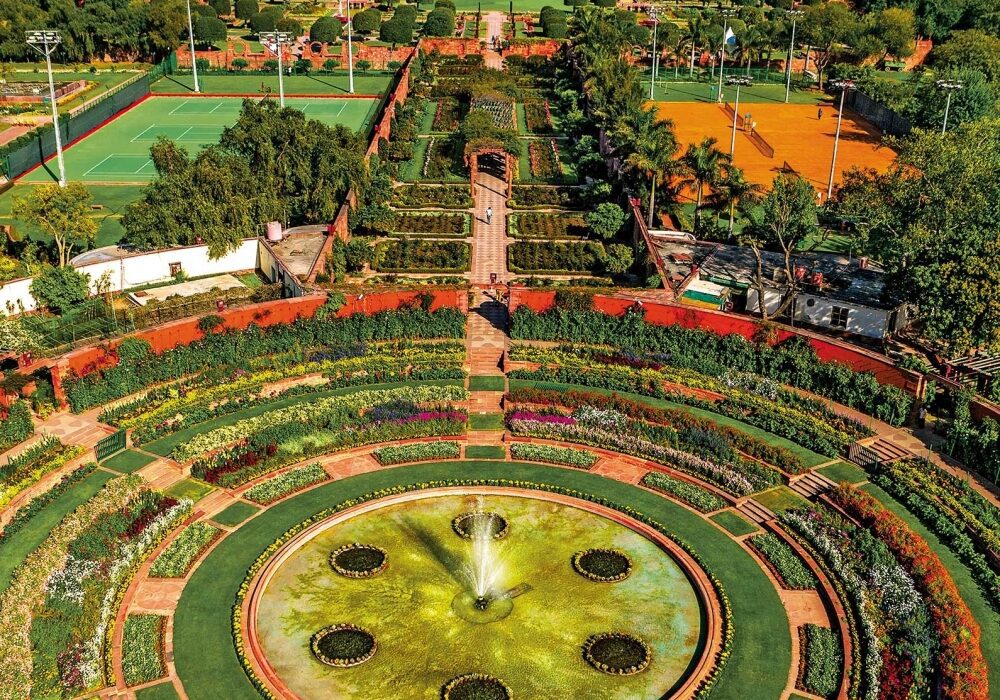The Mughal Garden has stood the test of time and is a stunning example of architectural and horticultural excellence. This garden, which was constructed during the Mughal Empire’s time in India, is evidence of the Mughal rulers’ grandeur and opulence. The Mughal Garden is a must-see for any visitor to India due to its unique combination of Persian and traditional Indian architecture.
Definition and brief history of Mughal gardens
From the 16th to the 19th centuries, the Mughal Empire established Mughal gardens in present-day India, Pakistan, and Bangladesh. A Muslim dynasty, the Mughal Empire, was established by Babur in 1526 and ruled over a significant portion of the Indian subcontinent for nearly 300 years. The Mughals were great supporters of the arts, and their gardens were a reflection of this. They combined elements of Persian and Islamic garden design with Indian customs from the area.
The traditional Islamic concept of paradise gardens was combined with the local Indian love of nature in the Mughal gardens, which were intended to be a fusion of nature and culture. They were typically arranged in a symmetrical, geometric pattern, with a pool or other central water feature and a variety of trees, plants, and flowers. These gardens became an important part of Mughal culture and society as a place of respite, reflection, and entertainment for the emperors of Mughal.
Additionally, the Mughal gardens were a representation of the empire’s wealth and power. They were intended to be a visual representation of the emperor’s authority and prestige and were frequently constructed close to tombs, palaces, and forts. Additionally, Mughal gardens were believed to reflect the Islamic concept of paradise and were constructed as a symbol of paradise on Earth.
The Taj Mahal Gardens, the Shalimar Gardens, the Nishat Bagh, the Bagh-e-Bahu, and the Rambagh Gardens are all well-known Mughal gardens. Millions of tourists continue to visit these gardens, which are regarded as some of the world’s most beautiful.

Role of Mughal gardens in Mughal culture and society
The gardens of the Mughals were an important part of Mughal society and culture. They not only served as a representation of the Mughal dynasty’s love of nature and interest in horticulture, but also of the empire’s wealth and power.
The Mughal emperors and their attendants relied heavily on the gardens as a haven of respite and relaxation. The gardens, which were frequently constructed in close proximity to tombs, forts, and palaces, were meant to provide a tranquil haven from the bustle of court life. The gardens were also used for entertainment and leisure activities like hunting and picnics, and the Mughal emperors frequently held court in them.
In addition, Mughal gardens played a significant role in the empire’s religious and cultural life. They were believed to be a representation of the garden of paradise described in the Quran and were designed to reflect the Islamic concept of paradise. They were frequently constructed in close proximity to tombs and shrines and served as a place of spiritual reflection and contemplation.
Mughal gardens not only played a significant part in the empire’s cultural and religious life, but they were also a significant source of artistic inspiration. They were celebrated in poetry and literature, and they were depicted in miniatures and paintings. They were also a source of inspiration for Mughal architecture, and many of the architectural elements and design characteristics of Mughal gardens were used to design buildings and monuments.
As a whole, Mughal gardens were an important part of Mughal culture and society. They were a reminder of the Mughal people’s love of nature, a place of respite and relaxation, a reflection of the empire’s wealth and power, and a source of inspiration for the arts and architecture.

Overview of key features and design elements of Mughal gardens
Mughal gardens are characterized by a number of key features and design elements that distinguish them from other types of gardens. Some of the most notable elements of Mughal garden design include:
- Symmetry: Mughal gardens are designed to be highly symmetrical, with a central axis or focal point that runs through the garden. This symmetry is often achieved through the use of geometric patterns and shapes, such as circles, squares, and stars.
- Water: Water is an important feature in Mughal gardens, and is often incorporated into the design through the use of pools, fountains, and channels. The central water feature, such as a pool or fountain, is often the focal point of the garden, and is surrounded by walkways and other elements that lead the viewer’s eye towards it.
- Terraces: Mughal gardens often include terraces, which are raised platform areas that provide a vantage point from which to view the garden. Terraces are typically divided into smaller compartments by walls or hedges, and are often used to separate different areas of the garden.
- Canals: Mughal gardens often include canals, which are used to channel water and create a sense of movement and flow through the garden. Canals are often lined with walkways and planted with a variety of aquatic plants.
- Pavilions: Pavilions are another common feature of Mughal gardens. These are small, open-sided buildings that are often used as a place to rest or as a vantage point from which to view the garden. Pavilions are typically decorated with intricate carvings and inlaid with precious stones.
- Trees and plants: Mughal gardens feature a variety of trees and plants, which are used to create a sense of color, texture, and movement in the garden. Trees and plants are often arranged in a specific pattern, such as a grid or spiral, and are used to create different “rooms” or “areas” within the garden.
- Charbagh: Charbagh is a feature of traditional Persian gardens, and is a quadrilateral garden layout divided by water channels and walkways into four smaller parts. It is believed to represent the four gardens of paradise described in the Quran.
- Rabaat: Rabaat is a feature of traditional Islamic gardens, and refers to the area close to the tomb of a saint or holy person. This area is usually dedicated to the memory of the person and is intended to serve as a place of spiritual reflection and contemplation.
These are some of the main design elements that are typically used in Mughal gardens. They are often combined in various ways to create unique and beautiful garden landscapes.
The Origins of Mughal Garden Design
Influence of Persian and Islamic garden design on Mughal gardens
Persian and Islamic garden design had a significant impact on the Mughal gardens, which were constructed in India during the Mughal Empire. The use of water channels, fountains, and pools to create a lush and verdant landscape was a characteristic feature of Persian gardens, which were also known as paradise gardens. Water was also a central feature in Islamic gardens, as were geometric patterns, symmetrical layouts, and the use of trees that provided shade. These elements were incorporated into the Mughal gardens, which also added their own distinctive characteristics, such as the utilization of elevated terraces and the incorporation of architectural elements like pavilions and kiosks. The end result was a blend of various garden designs that resulted in some of the world’s most stunning and well-known gardens.
Development of Mughal garden design under different Mughal emperors
The Mughal Empire, which spanned the 16th to the 19th centuries, was responsible for the development of Mughal garden design.
The gardens were simple and closely resembled the traditional Persian gardens he was familiar with under Emperor Babur, the first Mughal emperor. He introduced the charbagh, a type of garden divided into four quadrants by pathways or water channels.
Babur’s successor, Emperor Akbar, developed the charbagh concept and designed some of the most stunning Mughal gardens ever. He experimented with new architectural elements like pavilions and kiosks and constructed numerous large gardens, including the gardens at Lahore and Fatehpur Sikri.
The Mughal garden tradition was continued and expanded upon by Emperor Jahangir, who succeeded Akbar. He started several gardens to grow rare plants because he was particularly interested in botany and horticulture.
The famous Taj Mahal was constructed by Emperor Shah Jahan, who is also credited with designing some of the most exquisite and refined Mughal gardens. He constructed the renowned Rang Mahal, a palace on a raised terrace with beautiful marble pavilions and a garden.
The last of the great Mughal emperors, Emperor Aurangzeb, did not have the same interest in gardens as his predecessors did, and during his time in power, the state of Mughal gardens began to deteriorate.
Overall, the design of Mughal gardens evolved over time, with each emperor adding their own distinctive touch.
Evolution of Mughal garden design over time
As the Mughal empire and its rulers changed, so did the garden’s design. The use of water channels, pools, and geometric patterns were the primary elements in the gardens that were constructed during the early years of the empire, which were heavily influenced by Persian and Islamic design.
The Mughal emperors began to construct more elaborate gardens with architectural features like pavilions, kiosks, and raised terraces as their wealth and power increased. With a greater emphasis on symmetry and geometric patterns, the gardens became larger in scale and more formal in design.
The design of Mughal gardens reached its pinnacle during the time of Emperor Akbar. He designed numerous sprawling gardens, experimented with novel architectural techniques, and incorporated Indian garden design features like raised terraces and architectural details.
The Mughal garden style was developed and refined by subsequent Mughal emperors like Shah Jahan and Aurangzeb. They designed gardens that were more refined and elegant, placing a greater emphasis on ornamentation and aesthetics.
The Mughal Empire’s later years saw a decline in garden design due to economic and political factors. The Mughal empire was in decline as the emperors lost interest in garden construction and upkeep.
Overall, the Mughal garden design changed over time. It started out simple and looked a lot like the traditional Persian gardens. As the empire got richer and more powerful, it got more complicated and sophisticated.
Key Features and Design Elements of Mughal Gardens
Charbagh layout and symbolism
The Charbagh is a style of garden design that was also used in Mughal gardens and Persian and Islamic gardens. In Persian, the term “charbagh” literally translates to “four gardens,” referring to the garden’s four quadrants.
A central water channel or pathway that acts as the garden’s axis typically divides the Charbagh into four equal quadrants. A diverse and vibrant landscape is typically created by planting a variety of trees, shrubs, and flowers in the quadrants. The central water channel or pathway, which frequently features fountains or pools, connects the four quadrants and is used as a symbol in Islam to represent the four rivers of paradise.
The Charbagh layout is also a representation of the Islamic and Persian concept of paradise. The central water channel represents the river that flows through paradise, and the four quadrants represent the four corners of the world. With the four quadrants representing the four elements of the universe, the layout is also thought to represent the Islamic concept of unity: air, water, earth, and air
The charbagh layout was developed and refined in Mughal gardens, frequently incorporating architectural features like pavilions, kiosks, and raised terraces. The Mughals also added their own distinctive touch by incorporating Indian garden design features like raised terraces and architectural details.
Use of water and fountains in Mughal gardens
The Mughal gardens had a lot of water and fountains in the design. They were used to depict the Islamic and Persian concepts of paradise and to create a green and lush landscape.
The garden was divided up into sections by water channels, fountains, and pools. These features also served to provide a home for fish and birds that live in the water as well as a cool and refreshing environment. The four rivers of paradise in Islam are represented by the central water channel of a Charbagh layout. In addition to being used for irrigation and providing animals with a source of water for drinking, the use of water in Mughal gardens served a practical purpose.
Mughal gardens also featured a lot of fountains. They were used to cool the air and create a sense of movement and sound. To create a variety of water effects, pools, channels, and cascades were frequently used in conjunction with fountains. The Mughals also included a variety of fountain designs and types, including spray, jet, and tiered fountains.
Water and fountains were used in Mughal gardens not only for practical reasons but also for aesthetic and symbolic reasons. According to Islamic and Persian literature, the water and fountains were used to induce tranquility and a sense of paradise.
Use of flora and fauna in Mughal gardens
The use of a wide range of flora and fauna was a hallmark of Mughal gardens. The Mughal emperors’ love of gardening and horticulture led them to import a wide variety of exotic trees and plants from throughout their empire and beyond in order to decorate their gardens.
Mughal gardens featured a wide variety of flowers, including roses, jasmine, lilies, and many others. Flowers were an important part of Mughal gardens. Along with vegetables and herbs, the Mughals also farmed a wide range of fruit trees, including mangoes, oranges, lemons, and pomegranates.
Additionally, trees played a significant role in Mughal gardens. To create a diverse and lush landscape, the Mughals utilized a variety of trees, including willows, cypresses, and fruit trees. Additionally, they used trees to represent the Islamic and Persian concept of paradise and to provide shade.
In Mughal gardens, fauna also played an important role. In their gardens, the Mughals kept a wide range of birds, including pigeons, parrots, and peacocks. In addition, they kept aquatic animals like fish and turtles in the water channels and pools that were used to divide the garden into sections. The Mughals also kept elephants and lions, but they were kept in separate enclosures rather than in the garden.
According to Islamic and Persian literature, the Mughals used a wide variety of flora and fauna in their gardens to create a lush and verdant landscape and a sense of paradise.
Role of pavilions and other architectural elements in Mughal gardens
The design of Mughal gardens relied heavily on pavilions and other architectural elements. In addition to adding visual interest to the garden, they were used as a place to unwind, entertain, and reflect.
Mughal gardens frequently featured pavilions. They were usually built on terraces that were raised, so you could see the garden and the landscape around it. They were frequently used as a place for the emperor and his court to unwind and enjoy the garden, as well as a place to host guests. Additionally, music, poetry, and other cultural events were held in some pavilions.
Kiosks, which were small, open-air structures that were used for relaxation and entertainment in addition to viewing the garden, were another architectural element that was utilized in Mughal gardens. The Mughals also designed gardens with terraces and raised platforms. The terraces were frequently used to entertain guests or sit down and enjoy the garden.
Arches, pergolas, and trellises were just a few of the other architectural features that the Mughals included in their gardens. These features were used to provide shade as well as provide the garden with visual interest.
Overall, pavilions and other architectural features played a significant role in the design of Mughal gardens because they gave people a place to unwind, entertain themselves, and reflect, as well as added visual interest and privacy.

Famous Mughal Gardens
Overview of some of the most famous Mughal gardens
Some of the most famous Mughal gardens include:
- The Taj Mahal Garden: Located in Agra, India, the Taj Mahal Garden is considered one of the most famous Mughal gardens in the world. It was built by the Mughal emperor Shah Jahan in memory of his wife Mumtaz Mahal. The garden is a classic example of a Charbagh layout and features four quadrants divided by water channels, fountains, and pools. The garden also includes a raised terrace with a view of the Taj Mahal, and a variety of trees, flowers, and fruit trees.
- The Shalimar Gardens: Located in Lahore, Pakistan, the Shalimar Gardens were built by the Mughal emperor Shah Jahan in the 17th century. The garden is an example of a Persian-style garden and features a central water channel, fountains, and pools, as well as a variety of trees, flowers, and fruit trees. The garden also includes several pavilions, which were used for relaxation and entertainment.
- The Nishat Bagh: Located in Srinagar, India, the Nishat Bagh is a Mughal garden that was built by the Mughal emperor Jahangir in the 17th century. The garden is an example of a Charbagh layout and features a central water channel, fountains, and pools, as well as a variety of trees, flowers, and fruit trees. The garden also includes several terraces, which were used for relaxation and entertainment.
- The Bagh-e-Babur: Located in Kabul, Afghanistan, the Bagh-e-Babur is a Mughal garden that was built by the Mughal emperor Babur in the 16th century. The garden is an example of a Charbagh layout and features a central water channel, fountains, and pools, as well as a variety of trees, flowers, and fruit trees. The garden also includes several terraces, which were used for relaxation and entertainment.
- The Rauza-i-Munavvara: Located in Fatehpur Sikri, India, the Rauza-i-Munavvara is a Mughal garden that was built by the Mughal emperor Akbar in the 16th century. The garden is an example of a Charbagh layout and features a central water channel, fountains, and pools, as well as a variety of trees, flowers, and fruit trees. The garden also includes several terraces, which were used for relaxation and entertainment.
These gardens are considered to be some of the most famous Mughal gardens because of their architectural significance, beauty, and historical value. They have been well-preserved over time and are popular tourist destinations.
Conclusion
The Mughal Garden is a stunning display of architectural and horticultural excellence that has stood the test of time. The garden is a unique blend of traditional Indian and Persian styles, making it a must-see destination for any traveler visiting India. The Mughal Garden is not just a beautiful garden, it is also a symbol of the Mughal Empire’s greatness and a UNESCO World Heritage Site. It is an excellent example of Mughal architecture and horticulture, and it is a popular destination for tourists and locals alike. Make sure to visit the Mughal Garden on your next trip to India, you will not regret it.
Where is the Taj Mahal Garden located?
The Taj Mahal Garden is located in Agra, India.
Who built the Taj Mahal Garden?
The Taj Mahal Garden was built by the Mughal emperor Shah Jahan.
What is the garden layout of the Taj Mahal Garden?
The Taj Mahal Garden features a classic Charbagh layout with four quadrants divided by water channels, fountains, and pools.
Where is the Bagh-e-Babur located?
The Bagh-e-Babur is located in Kabul, Afghanistan.
Who built the Rauza-i-Munavvara?
The Rauza-i-Munavvara was built by the Mughal emperor Akbar in the 16th century.















